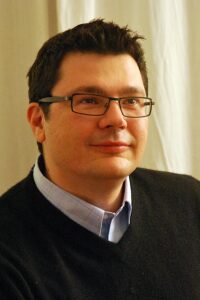
Dr. SLAVEN GARAJ
NANOPORE ANALYSIS OF BIOLOGICAL MOLECULES AND COMPLEXES
ABSTRACT:
Nanopore microscopy is a high-throughput, single-molecule technique capable of detecting the shape, structure and chemical properties of individual biomolecules and complexes, including DNA, proteins and viruses.
The technique relies on translocating molecule through a nanometre-scaled pore in a membrane, and measuring variation of the ionic current through the nanopore induced by the blocking molecule. The resulting signal is a good measure of chemical and physical properties of the part of the molecule residing within the pore at that moment. Biological pores could reach a resolution capable of discriminating individual nucleobases in the DNA molecules, and they led a revolution in DNA sequencing.
I will overview our recent development and general challenges of the synthetic pores: solid-state and twodimensional pores. Such pores are more versatile than biopores in terms of targeted biomolecular objects, detections modes and integration. We demonstrated that the nanopores are a critical method for investigating knots in biopolymers, and their dynamics. Furthermore, I will present our advances in the fabrication of atomically thin 2D-pores, and their capabilities for DNA detection. Finally, I will discuss perspective to expand nanopores as versatile platform for exploration of biomolecular complexes, and how could they serve biological community.
BIOGRAPHY:
Slaven Garaj’s research is focused on curious phenomena at the interfaces between soft and hard matter, with particular interest in single-biomolecule analysis using nanopores, nano-fluidics and nano-electronics. While pursuing in-depth scientific understanding, his research group drives the development of technologies in the fields of medical diagnostics, water filtration and energy harvesting; and his patents are currently licensed by a major biotech company. Slaven joined National University of Singapore in 2012 as a faculty member in the Departments of Physics and Biomedical Engineering, and has been awarded NRF Fellowship. Previously, he worked as a research scientist at Harvard University, where his pioneering work on nanopores for DNA sequencing received keen attention in media and top scientific journals such as Nature. He conducted his PhD thesis at the Swiss Federal Institute of Technology in Lausanne (EPFL), Switzerland in the field of condensed-matter physics.



